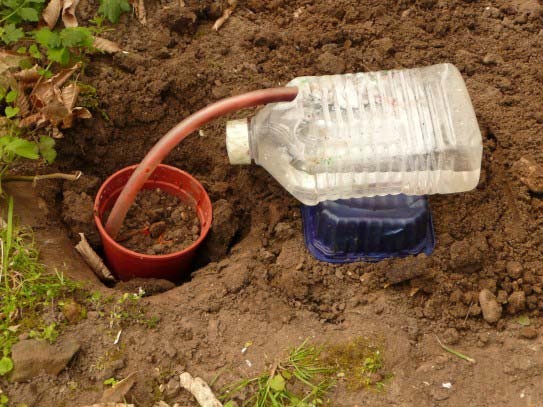In the past, we have written about different types of micro irrigation in EDN ; for example, we wrote about using clay pots for irrigation in EDN 97. This is a very good option, but unless pots are made locally, it can be expensive. Graham Knight of BioDesign in the UK has gathered information about wick irrigation, a type of micro irrigation with good potential as an inexpensive option for watering plants in dry areas, especially larger plants such as trees or plants in smaller areas like a kitchen garden.
Wick irrigation involves using “ropes as wicks to supply water to plant roots below the soil surface and thus minimize evaporation.” The water inside a pot or raised water container can be transferred to the soil by a rope wick (often inside a plastic tube to prevent evaporation). The concept is similar to a kerosene lantern with a wick, which keeps drawing fuel up the wick when the lantern is lit. Initially, water moves through the wick by capillary action. Later, water is continually pulled through the wick to replace water taken up by plants’ roots. Advantages of wick irrigation are many: 1) water consumption is reduced since evaporation is all but eliminated; 2) less time is needed for refilling containers; 3) there may be fewer problems with salt build-up, since the water will not evaporate at the surface and leave behind salt.

In some places in Cuba, rope wick irrigation is used on farms. A document from Cuba includes more about the advantages: “Wick irrigation uses no electricity, no large pipelines, [allows for] the use of fertigation [Ed: supplying plants with fertilizer dissolved in irrigation water] and causes no pollution or environmental destruction for its installation and implementation in rural or urban environments.” The system can be used in one area and later transported to another. It works equally well on flat or steeply sloping land. Installation does not require much in the way of planning or design, nor highly skilled labor. Because plants hopefully take up water as needed, the system does not require calculations and advanced planning. If the bottle is empty, it is time to add more water. (Wick Irrigation, a sustainable technology available to everyone; Pedro Ochoa Mena; Baracoa; 02/2010)
In a document about wick irrigation, Graham Knight described the wick technique: “Most ropes can be used for wicking but give varying flow rates. Usually the rope wick end is coiled around a plant [perhaps a tree seedling] and covered with earth. Where the wick has to be in the sun, it is wrapped with plastic film or tubing to prevent evaporation. To increase flow, the container can be raised. The soil around the wick soon becomes saturated, but it has been found that water consumption in most soils is negligible until plant roots grow towards the source of water and start to draw from it.” The system is similar to a bucket drip system, but water is supplied with wicks instead of drip emitters.
Mr. Knight has shared that most ropes wick quite well, but not all. Nylon, acrylic and polyester wicks can often be used for more than one season. Some ropes made of cotton or jute will wick well at first, but rot quickly. Before testing wicks, wash them in detergent and leave them to soak for about two hours (since some ropes are treated to prevent wicking). Then drape each wick over the side of a bowl of water, with a small container under the free end of each one. Measure how long it takes for the drips of water from each wick to fill the small containers.
Mr. Knight would like feedback about different wicks. If you are interested to work with him doing some simple wick testing, contact him at diysolar@btinternet.com .
You can view a short video about wick irrigation at www.youtube.com/watch?v=1MRtdrJFm3Q .

Mr. Knight’s outline includes a few helpful links about smallscale irrigation for arid areas, including the following:
- www.zaragoza.es/contenidos/medioambiente/cajaAzul/11S4-P2-JJRamirezAlmorilACC.pdf A helpful document outlining several methods for irrigation in dryland areas.
- www.fao.org/docrep/W3094E/w3094e05.htm From an FAO document called “Small-scale irrigation for arid zones: Principles and options.” Chapter 4 contains “Criteria and options for appropriate irrigation methods.” The document is available in English and French.
Cite as:
Berkelaar, D. 2012. Wick Irrigation. ECHO Development Notes no. 115